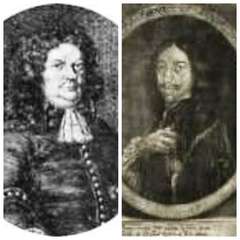|
Back
Laments and Dances, Quirks and All New York
Baruch Performing Arts Center
10/11/2019 -
Johann Rosenmüller: Sonata Nona, from Sonate a 2, 3, 4 e 5 stromenti da arco e altri
Heinrich Ignaz Franz von Biber: Sonata I, “The Annunciation from Mystery Sonatas – Sonata V from Sonatae violino solo – Sonata Prima from Fidicinium Sacro-Profanum
Johann Heinrich Schmelzer: Polnische Sackpfeifen from Rost Codex – Harmonia a 5 – Lamento sopra la morte di Ferdinando III from Rost Codex
Johann Caspar Kerll: Toccata 4, Cromatica con durezze e ligature, from Toccate, Canzoni, ed altre Sonate
Samuel Scheidt: Gailliard Battaglia from Ludi Misici – Canzon super “O Nachbar Roland” from Ludi Misici
Sonnambula: Elizabeth Weinfield (Artistic Director, Tenor viol), Jule Ziliak, Toma Iliev (Violins), Amy Domingues (Tenor viol), Shirley Hunt (Bass viol), James Kennerly (Organ)

Sonnambula (© Courtesy of the Artists)
I've done a lot of performance practice, Baroque playing, and some of the joy and the challenge of it is figuring out what the composer intended... You have music of the 17th century - it's all whole notes and half notes. But inside of that, there are so many things that one can do, at least according to what we know about performance practice.”
Caroline Shaw (1982-)
To New York’s specialized audiences, the words “early Baroque music” are as ill-defined as “Chinese food” or “dog”. Are we speaking of Lully’s ballets and regal dances? Tartini’s acrobatics or Teleman’s perambulations? Gesualdo’s madrigals, or Queen Elizabeth’s “Don’t ask, don’t tell” Catholic favorite, William Byrd?
Bach and Monteverdi are outside of these categories for two reasons. First, they were both head and shoulders above all the others, no matter how deft they were. Second, Bach was confined to North Germany, as were most of the Lutheran composers of the 17th Century. Like today’s Kosovo or Cyprus, Central Europe was divided by religious hatred. The Prussian reformers of the Holy Roman Empire and the Catholic traditionalists of (what would become) the Austro-Hungarian Empire. The Thirty Years War between Catholics and Lutheran Protestants had ended officially in 1648, but the hatreds continued for centuries later.
Last night, the “early Baroque performers” of Vienna and southern Europe offered their relatively unknown composers at Baruch (not to be confused with “Baroque”) Performing Arts Center. Sonnambula, the early-music sextet, offered apparently highly professional performances, with quite a few quirky innovations.
I say “apparently”, since my own tastes are more favored and relatively knowledgeable for the more dramatic or balletic composers listed above. But one certainly was titillated (if not emotionally thrilled, like some members of the audience) with the artistry shown here.
Johann Rosenmüller’s first Sonata for the whole ensemble was an example of 17th Century eccentricity, Not the slow-fast-slow construction, but how each section ended. These were ordinary cadences, yes, but they ended with a suddenness, as if the composer wanted to give us all a tiny unexpected shock. Add to this a deft little fugue, and satisfaction was complete.
The following two violin solos, with organ and viol as extended basso continuo, showed fiddlers Jude Ziliak and Tom Iliev at their technical best, this for composer Biber, whose music is still to be heard in today’s concert halls. Yes, the sounds were hardly as muscular as their finger work for the variations. But this was music to be played in the home or small churches. Concert-halls themselves hadn’t been invented yet, and cathedrals were made for choruses or Gabrielli-type brass ensembles.
The artist behind the Baroque organ, James Kennerly, played a short work by Johann Caspar Kerll, himself an organ virtuoso. The dissonances were interesting, the final major-key finale unexpected.

J.Rosenmüller/J. H. Schmelzer
Three works by one Johann Heinrich Schmelzer showed three faces of a man known as the finest violinist in all Central Europe. Though hardly a competitor to Tartini down in Italy. His Harmonia à 5 ended the program with a good picture of a master contrapuntalist. His Lament for the death of Ferdinand III, ruler of the Holy Roman Empire, was mournful enough, but included some marching songs as well. A good miscellany, though I personally would choose a less somber work for my own demise.
Then again, his pictorial Polnische Sackpfeifen was actually jolly. The title means “Polish Bagpipes”, and the ensemble did imitate, with other pictorial effects, the drone and tunes of an ordinary bagpipe. “Polish”, though, was a puzzle. We all know the Moroccan and Celtic bagpipes. When did Poland get them? And what was the story behind the episodes?
Finally we have Samuel Scheidt, and the single work with which I was acquainted. Not the Battle Galliard, a dance tune which, one imagines was performed by soldiers during an interlude of their bloody war.
The Neighbor Roland piece, not to be confused with the fictional hero of the Crusades, avatar of many other musical works, was a whimsical music based on either a Scheidt original or a folk-song. I had played this in a recorder quintet many years ago with joy, since this was a good example of early Baroque fungibility.
One admires how Sonnambula played their music with a paucity of introductions. Yet, except for the truly devoted, a few written explanations might have helped. Early south Europe Baroque music was, after all, hardly monolithic, and an explanation of notated variants would have stimulated the audience as much as the notes themselves.
Harry Rolnick
|